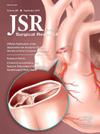A Nationwide Analysis of Outcomes, Healthcare Encounters, and Costs of Small Bowel Obstruction
IF 1.7
3区 医学
Q2 SURGERY
引用次数: 0
Abstract
Introduction
Small bowel obstruction (SBO) is a prevalent and clinically challenging condition. Surgical interventions may be relatively high-risk for vulnerable populations, like the elderly and underinsured. We investigated the sociodemographic characteristics, clinical outcomes, and hospital characteristics of SBO encounters to better understand risk factors.
Methods
We utilized the 2020 National Inpatient Sample database for adults (age ≥ 18 y) with a diagnosis of SBO, identified using International Classification of Diseases, 10th Revision, Clinical Modification codes. International Classification of Diseases, 10th Revision Procedure Coding System codes were used to define the type of management. The primary outcome was mortality. The secondary outcomes were inpatient cost and length of hospital stay.
Results
Among 246,395 patients with SBO, 25,083 (10%) underwent operative management (OM) and 221,312 (90%) underwent nonoperative management (NOM). Among all patients, majority were female (56%), used Medicare (58%), were White (72%), with a mean age of 65. NOM patients were discharged home more often (75% versus 53%, P < 0.001). OM patients experienced more mortality (4.5% versus 1.4%). OM patients were treated at urban teaching hospitals (71% versus 67%, P < 0.001) more often and had shorter lengths of stay (4.2 versus 11.1 d, P < 0.001) with lower inpatient costs ($11,124 versus $35,346, P < 0.001) compared to NOM. In adjusted analyses, patients aged 75-84 had 9.0 times greater odds of mortality (adjusted odds ratio: 9.0, P < 0.001), and OM had 3.3 greater odds of mortality (adjusted odds ratio: 3.3, P < 0.001).
Conclusions
SBO patients undergoing NOM were found to have longer hospital stays and higher inpatient cost, but overall lower odds of mortality compared to their operative counterparts. These findings may help guide decision making regarding SBO management, especially in the elderly population.
全国范围内对小肠梗阻的结果、医疗遭遇和费用的分析
小肠梗阻(SBO)是一种常见且具有临床挑战性的疾病。手术干预可能是相对高风险的弱势群体,如老年人和保险不足。我们调查了SBO遭遇的社会人口学特征、临床结果和医院特征,以更好地了解危险因素。方法:我们使用2020年国家住院患者样本数据库,收集诊断为SBO的成人(年龄≥18岁),使用国际疾病分类第10版临床修改代码进行鉴定。采用国际疾病分类第十次修订程序编码系统代码定义管理类型。主要结局是死亡率。次要结局是住院费用和住院时间。结果246395例SBO患者中,25083例(10%)接受了手术治疗(OM), 221312例(90%)接受了非手术治疗(NOM)。在所有患者中,大多数为女性(56%),使用医疗保险(58%),白人(72%),平均年龄为65岁。NOM患者出院回家的频率更高(75%比53%,P < 0.001)。OM患者的死亡率更高(4.5%对1.4%)。与NOM相比,OM患者在城市教学医院接受治疗的频率更高(71%对67%,P < 0.001),住院时间更短(4.2对11.1 d, P < 0.001),住院费用更低(11,124美元对35,346美元,P < 0.001)。在调整分析中,75-84岁患者的死亡率高出9.0倍(调整优势比:9.0,P < 0.001), OM患者的死亡率高出3.3倍(调整优势比:3.3,P < 0.001)。结论与手术患者相比,接受NOM治疗的ssbo患者住院时间更长,住院费用更高,但总体死亡率较低。这些发现可能有助于指导SBO管理的决策,特别是在老年人群中。
本文章由计算机程序翻译,如有差异,请以英文原文为准。
求助全文
约1分钟内获得全文
求助全文
来源期刊
CiteScore
3.90
自引率
4.50%
发文量
627
审稿时长
138 days
期刊介绍:
The Journal of Surgical Research: Clinical and Laboratory Investigation publishes original articles concerned with clinical and laboratory investigations relevant to surgical practice and teaching. The journal emphasizes reports of clinical investigations or fundamental research bearing directly on surgical management that will be of general interest to a broad range of surgeons and surgical researchers. The articles presented need not have been the products of surgeons or of surgical laboratories.
The Journal of Surgical Research also features review articles and special articles relating to educational, research, or social issues of interest to the academic surgical community.

 求助内容:
求助内容: 应助结果提醒方式:
应助结果提醒方式:


